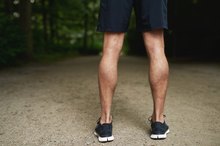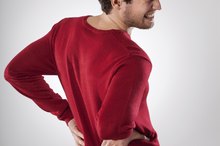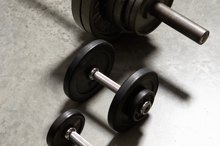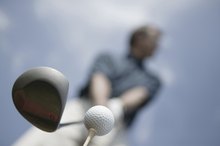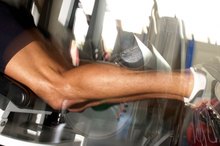How to Tell If You Pulled a Muscle
You don't have to be a body builder to suffer from a pulled muscle; even normal daily activities put your muscles at risk for overuse or excess pressure. Pulled muscles, or muscle strains, can cause significant discomfort but are usually not serious. Treatment for most strains usually includes a combination of ice, rest and over-the-counter medications.
Physical Symptoms
A muscle that has been pulled may feel slightly sore with a dull, aching kind of pain. Pulled muscles can also feel more acutely painful, especially when the affected muscle is being used. Some pulled muscles are also sore or tender to the touch. The joints near the injured muscle may also be sore. Pressure and tension usually cause the pain to intensify.
- A muscle that has been pulled may feel slightly sore with a dull, aching kind of pain.
- The joints near the injured muscle may also be sore.
Visual Inspection
Knots After a Hard Shoulder Workout
Learn More
Minor muscle strains may not cause any visual symptoms, but moderate to severe strains can cause symptoms that you can see. The area near the pulled muscles is often slightly swollen or red. If your strain was significant enough to tear the fibers and cause bleeding around the muscle, you may see a bruise near the injury site that worsens with time.
Contextual Considerations
Muscle pulls occur under two different contexts. The first is an acute muscle strain that occurs during a physical activity. These kinds of strains cause immediate pain that often feels like shooting or burning at first, and then fades into a more general soreness. In severe cases, you may hear a snapping or popping sound when the injury occurs. The second type of strain is the result of prolonged muscular stress. These kinds of strains typically cause pain that sets in gradually, and you may only be aware of them during periods of rest.
- Muscle pulls occur under two different contexts.
- These kinds of strains typically cause pain that sets in gradually, and you may only be aware of them during periods of rest.
Other Possibilities
Hyperextension of the Calf
Learn More
A muscle strain is different from a sprain, which is damage to ligaments, rather than muscle tissue. Sprains are more common around joints like the wrists and ankles. Muscle cramps cause a similar kind of pain, but are related to an uncontrollable contraction of your muscles, and usually once the cramp subsides the pain dissipates as well. Generalized muscle soreness that is not connected to any specific activity or injury may be related to a number of other medical conditions. If you are experiencing other symptoms, like fever, nausea or extreme fatigue, you should see a doctor to identify the cause.
- A muscle strain is different from a sprain, which is damage to ligaments, rather than muscle tissue.
- Muscle cramps cause a similar kind of pain, but are related to an uncontrollable contraction of your muscles, and usually once the cramp subsides the pain dissipates as well.
Related Articles
References
- E-Medicine Health: Muscle Strain
- New York University: Muscle Strain
- MedlinePlus: Muscle Aches
- Hospital for Special Surgery, "Muscle Strain: What You Need to Know About Pulled Muscles."Nov.2019
- Kary JM. Diagnosis and management of quadriceps strains and contusions. Curr Rev Musculoskelet Med. 2010;3(1-4):26–31. doi:10.1007/s12178-010-9064-5
- Levine WN, Bergfeld JA, Tessendorf W, Moorman CT. Intramuscular corticosteroid injection for hamstring injuries. A 13-year experience in the National Football League. Am J Sports Med. 2000;28(3):297-300. doi:10.1177/03635465000280030301
- Ranatunga KW. Temperature effects on force and actin⁻myosin interaction in muscle: A look back on some experimental findings. Int J Mol Sci. 2018;19(5):1538. doi:10.3390/ijms19051538
- Schmitt B, Tim T, McHugh M. Hamstring injury rehabilitation and prevention of reinjury using lengthened state eccentric training: A new concept. Int J Sports Phys Ther. 2012;7(3):333–341. PMID:22666648
- Mair SD, Seaber AV, Glisson RR, Garrett WE. The role of fatigue in susceptibility to acute muscle strain injury. Am J Sports Med. 1996;24(2):137-43. doi:10.1177/036354659602400203
- Noonan TJ, and Garrett WE, "Muscle Strain Injury: Diagnosis and Treatment" J. Am. Acad. Ortho. Surg., Jul 1999; 7: 262 - 269.
Writer Bio
Hannah Wahlig began writing and editing professionally in 2001. Her experience includes copy for newspapers, journals and magazines, as well as book editing. She is also a certified lactation counselor. She holds a Bachelor of Arts in English from Mount Holyoke College, and Master's degrees in education and community psychology from the University of Massachusetts.

